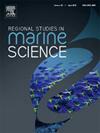Spatio-temporal graph neural network fused with maritime knowledge for predicting traffic flows in ports
IF 2.1
4区 环境科学与生态学
Q3 ECOLOGY
引用次数: 0
Abstract
The COVID-19 pandemic highlighted significant challenges in maritime industries, such as port congestion and supply chain disruptions, necessitating accurate port traffic prediction. Traditional models often fail to capture the complex and dynamic interactions within maritime networks, particularly the spatial correlations between ports. To address these limitations, this study proposes a spatio-temporal graph neural network (MSTGNN) tailored for maritime traffic prediction. MSTGNN integrates temporal and spatial features using a sample convolution and interaction network (SCINet) and a graph attention network (GAT), enhanced by a k-core mechanism for prioritizing key ports. Extensive experiments with global and regional datasets demonstrate MSTGNN's superior performance in accuracy, stability, and adaptability compared to existing models. The model excels in predicting traffic flows across different ship types, making it highly applicable for optimizing port operations, route planning, and mitigating supply chain risks. The findings imply that MSTGNN can significantly enhance decision-making in maritime logistics by offering more precise traffic predictions, thereby supporting more efficient, resilient, and sustainable global supply chains.
求助全文
约1分钟内获得全文
求助全文
来源期刊

Regional Studies in Marine Science
Agricultural and Biological Sciences-Ecology, Evolution, Behavior and Systematics
CiteScore
3.90
自引率
4.80%
发文量
336
审稿时长
69 days
期刊介绍:
REGIONAL STUDIES IN MARINE SCIENCE will publish scientifically sound papers on regional aspects of maritime and marine resources in estuaries, coastal zones, continental shelf, the seas and oceans.
 求助内容:
求助内容: 应助结果提醒方式:
应助结果提醒方式:


